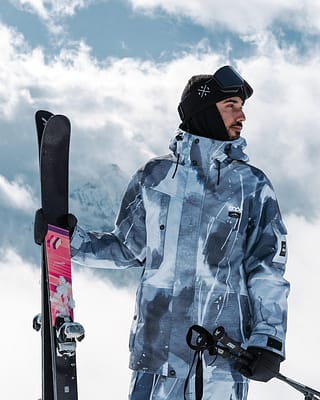How to choose a ski jacket
Level up your ski jacket! We get that you want to look stylish. How else will other riders notice you from the chair, right? However, don’t forget to look for key design elements to keep you dry, comfortable, and warm. Feeling confused? We’re here to help with our one-stop guide on how to choose a ski jacket.

Finding the perfect ski jacket isn’t always the easiest thing to do. Pick at random and you might end up with outerwear that makes you too hot, too cold, doesn’t keep you dry, or leaves you just plain miserable.
You’re not alone, though. We’re here to help with our awesome ski jacket guide. You’ll soon know your waterproofing from your breathability, what’s best for the slopes versus the backcountry, and so much more. So, let’s unzip and dive into it!
Select a ski jacket type
Understand waterproofing vs. breathability
Look for key features
Consider the fit and style
Select a ski jacket type

Ski jackets come in a few different types. That’s the first thing to know! There are various styles suited to different skiing conditions, times of year, and terrain. So, consider whether you’ll need extra warmth when cruising in-bounds mid-January or a super light and breathable design for spring park laps.
Insulated
- Conditions: Cold, wet conditions.
- Best for: Beginner skiers and in-bounds or backcountry terrain.
An awesome choice for colder temps, insulated jackets feature built-in insulation to keep you toasty on the chair up and during super-cold descents. Because the insulation is fixed to a waterproof outer shell, you rarely have to layer much underneath (a bonus if you’re new to skiing and still figuring that part out). The majority of jackets come with a synthetic insulation that mimics natural down by trapping air pockets to keep you nice and warm.
The amount of insulation can vary from jacket to jacket and differ throughout the design itself. But the main thing to remember is that higher numbers represent greater insulation. For example, 60g (sometimes written as ‘gsm’) is classed as medium-weight insulation for reliable warmth while 200g is heavily insulated and effective when the mercury is rock bottom, allowing you to take on fresh lines in the freshest temps.
Shell
- Conditions: Varied conditions throughout winter.
- Best for: Slopes/all mountain, backcountry, and ski touring.
Shell ski jackets are insulation-free to keep you light on your feet. They still have the same waterproofing to protect you from the elements, but because they have no built in insulation, you’re less likely to overheat on sun-soaked slopes or when skinning up off-piste. And when the snow gods turn down the thermostat? You can layer underneath to stay warm.
Fair warning, if you’re looking for the simplest option, a shell ski jacket might not be for you. You’ll need to think a little harder about layering, but if the thought of putting on or taking off a fleece doesn’t bother you, they’re definitely the most versatile option, letting you switch things up for in-resort runs and more technical freeriding descents.
Softshell
- Conditions: Mild temperatures, dry days, and spring conditions.
- Best for: Slopes/all mountain, park, backcountry, and ski touring.
Hitting spring slush? A softshell is your jam. Softshells are highly breathable and lightweight making them ideal for warmer weather, end-of-season laps, and drier climates, such as those found in Alta or Snowbird. Softshells also move with you, offering more stretch than a shell. Combined with high breathability, this makes softshells perfect for high-output sessions (such as intense park laps) and sweat-inducing touring ascents.
A lot of softshells won’t offer bombproof weather protection in extreme conditions like a shell jacket will, and they aren’t as toasty as an insulated ski jacket, either. However, they are cosy, comfy, and some of them will have 10k or even 15k of waterproofing! More than enough for a couple of spring park spills.
Understand waterproofing vs. breathability

Waterproofing and breathability are crucial ski jacket factors. After all, you’re going to be around snow; whether it’s falling on you or you’re falling onto it! So, keeping dry is key. And breathability? Without it, sweat becomes trapped inside the jacket, and you end up a damp, uncomfortable mountain mess. Trust us, it’s not a good look.
How are waterproofing and breathability measured?
- Waterproofing = millimeters (‘mm’). This measurement shows how much pressure your ski jacket can withstand before it’s penetrated by water
- Breathability = grams (‘g’ or ’g/m2/24hr’). This shows the amount of water vapor that can pass through a square meter of fabric in 24 hours
- Both ratings are often shown together, such as 15,000 mm/15, 000 g
Waterproof and breathability ratings rise in increments of a thousand (that’s why some ratings are written as ‘K’). So, the higher the rating, the more waterproof or breathable the jacket is. For life in the mountains, jackets with a minimum rating of 15,000mm/15,000g are more than enough for almost all conditions! Who wants to ride in the pouring rain anyway!?
Some ski jackets offer enhanced waterproof performance in tougher conditions by adding features like a DWR (durable water repellent) finish, a double placket over the front zipper, and fully or critically taped seams. And for extra breathability? Vents, of course! Which brings us to the next section…
Look for key features
Now you know how ski jackets perform, it’s time to dive into the details. These elements might seem small. However, they make a big difference to your day on the hill. So, let’s check them out…
Vents
Most ski jackets have zipped vents under the arms (also known as ‘pit zips’). These are perfect for unzipping and blowing off heat without removing the whole jacket. Some vents have a mesh lining to stop snow from entering your jacket during those unexpected falls.
Pockets
Ski jackets might have media pockets, chest pockets, internal pockets, and more to keep your prized possessions (including snacks) safe and secure. And a lift ticket pocket is particularly handy for a seamless glide through the turnstiles.
Adjustable hood
Adjustable, helmet-compatible hoods open up to fit over a helmet when riding or tighten over a beanie on the way back from après. You might spot multiple adjustment points, such as the front and back, providing a perfect, protective fit.
Snow skirt
A snow skirt keeps you dry in the deepest pow! It’s an elasticated internal piece of material that sits above the hem and prevents snow from getting up and into your jacket (especially during tomahawks). Look for an adjustable snow skirt for a comfortable, stay-put fit.
Wrist gaiters
Wrist gaiters fit over your hands and underneath your gloves or mittens. These act as an additional barrier, stopping snow from going up your sleeves!
Consider the fit and style

Next, think about whether you prefer a fitted style, more freedom of movement with a looser cut, or something in between. A park rat, for example, might select a baggier, relaxed jacket to make room for those countless rotations and stomps. A backcountry adventurer might choose a more fitted design for better thermal insulation.
As for style, do you want a pullover design, a full-zip, half-zip, or something else? Each one has its own benefits. For example, a zipless construction generally provides total waterproofing, while a full-zip design is easier and quicker to take off. A drop hem also provides protection on those super cold chairs. So, consider what you like. And what style points you’re after.
FAQs
How many layers should I wear under my ski jacket?
Most riders follow the 3-layer system: a moisture-wicking base layer to regulate temperature and keep sweat off the skin, an insulating mid-layer like a fleece or lightweight puffer (or built-in insulation), and an outer shell ski jacket for weather protection. The number of layers can vary depending on weather and personal preference – colder days might call for more layers, while warmer ones may let you skip the mid-layer. Some people also naturally run hotter or colder, so the key is to find what feels most comfortable for you.
Should I size up in a ski jacket?
Sizing up a ski jacket is totally down to personal preference. If a ski jacket is marked as a ‘regular’ fit, it’s typically made with enough room to layer underneath. However, some riders might opt for a larger size jacket for thicker insulating layers below (especially with a shell ski jacket). Others might size up a regular-fit jacket for a baggier look.
Whichever style you choose, make sure you have plenty of room to move. If you’re feeling restricted or the arms are too short, consider sizing up your ski jacket. You might also want to size up if you’re between sizes. And you can always refer to the size chart of the brand you’re buying from for more info.
Wrapping up
Now it’s time for the fun part: hunting for your next ski jacket! So, take into account what you’ve learned and go forth to find your new-season setup. We can’t wait to see your fresh look on the mountain.
Have a question about a particular Dope Snow jacket? Or want to know more about our production process, insulation, colors, or designs? Reach out to our whizz team at crew@dopesnow.com. Our team knows the ins and outs of every product and is raring to pair you with your new favorite style.
Explore fresh ski jacket styles from Dope
Related reading:


